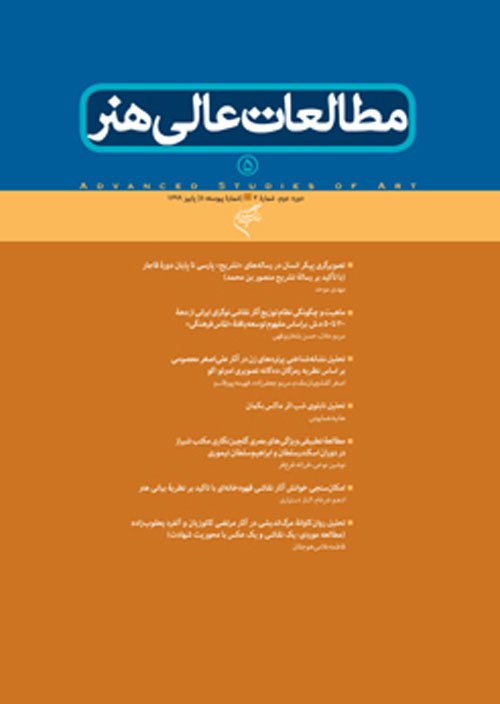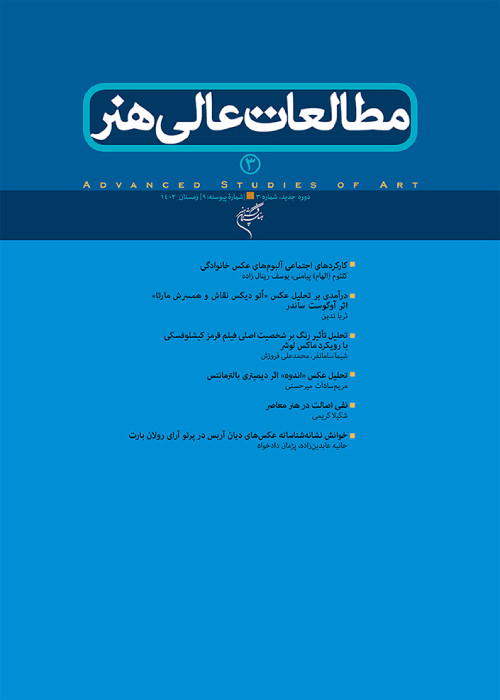فهرست مطالب

نشریه مطالعات عالی هنر
سال دوم شماره 3 (پاییز 1399)
- تاریخ انتشار: 1399/12/14
- تعداد عناوین: 7
-
صفحه 63
-
Page 7
Around 800 AH/1499 CE Mansūr ibn Muḥammad wrote a treatise on anatomy re-nowned as the first Persian illustrated anatomical work with full-page diagrams of the human body which were depicted in squatting position. In contrast with these “tradi-tional” illustrations, it seems that the “modern” depiction of the human body became popular right after the introduction of European medicine to Persia. Accordingly, to shed light on the way Persians passed from the traditional anatomical illustrations to modern ones, investigations are still needed to be done. In addition to explaining the features of these illustrations chronologically, this paper provides information to push forward the understanding of the interaction between advances of medical sciences and anatomi-cal illustrations until the end of Qajar dynasty. As a result, it is evident that anatomical illustrations of Mansūr’s treatise established a tradition, which continued for about half a millennium. This long-lasting tradition was due to the continuous reliance of Persian medicine on its Galenic origin, which was dominant from the 3rd century AH. It also indicates that in spite of being familiar with the modern figures of European anatomi-cal books from the 11th century AH, Persians made use of “modern” illustrations of the human body in the second half of the 13th century AH. The earliest images of modern human body appeared after the establishment of Dār al-Funūn (c. 1266 AH). Thereaf-ter, “modern” images of human body replaced “traditional” illustrations. Following this change, a wide range of modern images appeared in Persian anatomical print books.
Keywords: Anatomy, Mansur’s Anatomy, Illustration, Human Body, Safavids, Qajars -
Page 29
The consolidation of modernist painting in Iran is due to the existence of individuals and institutions that have played an effective role in distributing modernist paintings to consumers. They act as intermediaries between the producer and the consumer. Their existence owes much to the artist’s advancement from a craftsman to a genius one be-tween the 15th, Renaissance, and the 18th century. These individuals and institutions have been referred to in the Theory of Art world which has been formed by Howard S. Becker, as the distribution system; Victoria D. Alexander has used this theory to devel-op the concept of Wendy Griswold’s “cultural diamond” which is a tool that explains the interconnections among the elements involved in the relationship between culture-art, and the social world, however, it does not reveal the quality of these relationships. The changes made by Alexander in this sense help better understand these relationships. The distribution system is not only responsible for presenting cultural and artistic works, but also, with the help of mechanisms that are of consolidating or rejecting an artistic movement and artist in the field of art, as well as determining the content of works of art, can be substantially influential. The distribution of modernist Iranian paintings throughout three decades, are mostly indebted to the establishment of exhibitions, galleries, bienni-als. Other individuals and institutions have also played an important role in their distribu-tion. In this descriptive-analytical article the identity of these individuals and institutions, their performances in the distribution system and the impact of some of the lesser-known examples on the distribution of Iranian modernist paintings have been questioned. The results showed that training centers, artistic circles and critics have been among the fac-tors involved in the distribution system and the important impacts of these factors are not fully observed as well as others.
Keywords: Modern Iranian Painting, Cultural Diamond, Art World Theory, Distribution System, Distributors -
Page 45
The knowledge of semiology is focused on the process of defining a composition. The female portraits represented by Ali Asghar Masoumi triggers the visual and discoursal demonstration in the observers’ mind; leading to a deeper understanding of the paint-ings. This article investigates and analyzes the definition behind female portraits and adjusts the meanings accordingly. Based on Umberto Eco’s theory, the research aims to respond to two main questions: “what conversations have the signs on these portraits started?” and “which instance the deepest signs in these portraits are being shared?” aiming to further analyze the signs implemented in Masoumi’s work based on Eco’s visu-al code theory. The research showcases the female portraits in a gendered, and icono-graphic spectrum, affected and engrained by cultural and traditional values. The layered semiotics and visual codding leads the onlooker to maintain a unique interpretation of the implementations. This article has been conducted by descriptive analysis and library research method.
Keywords: Semiotics, Semiology, Eco, Female, Portrait, Ali Asghar Masoumi -
Page 63
Max Beckmann suffers from the general human condition. He shows unpleasant social, political relationships and mental anxieties in his paintings which is the sign of his contro-versy with the problem of existence. His language is symbolic, in the way that by observ-ing the roles we understand that these elements except for impromptu experiences are selected. Beckmann intended to express the problems of existence by symbol and myth. His intention is the expression of life myth and the main issue of his painting is human myth. In this research, the Night Painting in which Beckmann’s mysterious symbolism is not still understood completely, is investigated with the emphasis on formalistic, aesthetic, sociological critique and also with examination of symbols and the meaning of the paint-ings by descriptive-analytical approach and in this way and route, the visual works and written sources are used. Max Beckmann who lived in the heart of the post-war mental crises and its consequences, is involved with the object and space opposition for new interpreting of reality and applied grotesque forms due to their opposition to conventional social, political, religious and cultural norms to create a violent atmosphere. His paintings often encompass mythological allusions to the cruelty of the Nazis and beyond that, they show and express subjects and symbols of universal themes of terror, salvation and the secrets of eternity and destiny.
Keywords: Max Beckmann, Nacht, Neue Sachlichkeit, Criticism, twentieth century -
Page 81
The school of Shiraz Timuri is one of the most influential schools in Iran, formed during the governance of Eskandar Sultan and continued in the age of Ibrahim Sultan One of the common features of this period is anthology of literary texts, which is important as a valuable source for comparing the quality of the illustrations during the Eskandar Sultan and Ibrahim Sultan period. For this purpose, in this study, the pictorial and structural features of the manuscripts of the anthology of Eskandar Sultan in the Galouste Gulbenkian Foundation of Lisbon and the anthology of the poems of Ibrahim Sultan in the Berlin State Museum have been studied. The purpose of this basic research, which has been done by using descriptive, analytical methods with a comparative approach, is to find the visual and structural relationship between the versions of these two periods and to answer this question: Considering the temporal, spatial and cultural similarity of Shiraz school during the reign of Eskandar Sultan and Ibrahim Sultan, what are the commonalities and differences between the visual and structural features of the anthology of these two periods? Data collection was done using library resources, documents and virtual databases. The research results show that although many similarities such as scene selection, realistic approach, tabulation and annotation can be seen in the anthology of these two eras, but the multiplicity, variety and quality of visual elements have decreased in the time of Ibrahim Sultan and composition has played a different role and less prosperous effects than in the previous era.
Keywords: Timuri Painting, Shiraz School, Eskandar Sultan, Ibrahim Sultan, Anthology -
Page 99
The expressive theories in art perceive the meaning of artworks as a form of showing emotions. As the overview of the Tea-House paintings indicates, there are some charac-teristics in these works through which the painters attempt to express emotions by using specific arrangements and conventions. In this regard, the central question in this study was that how can we interpret Tea-House paintings using the expressive theory of art. The purpose of the study was to elucidate expressive aspects in Tea-House paintings. Tea- House painting is kind of a narrative painting holding religious heroic and festivity remarks. Such works were raised at the time of constitutional movement by non-edu-cated artists. In Tea-House paintings works, the beliefs which existed in the minds of street people of middle layers of urban Society, were illustrated. Tea-House painters had limitary oil color technics practically with the help of their great faith and enthusiasm. Tea-house painters are concerned with conveying their emotions and influencing their audiences. The importance of studying the works through the theoretical approaches of art such as expressive theories is that they can reveal the workings of these paintings and determine through which arrangements the artists have expressed their emotions. This was a descriptive-analytical study and the data was collected through library re-search method. Moreover, this study attempted to present pictorial instances according to the available examples for better understanding of the concepts. The analysis of the Tea-House paintings showed that expressing emotions is crucial in these works and is in a way one of the most important purposes of the painters. The methods and solution used by Tea-House painter include, how to use the form, show the characters’ moods, and use color. It could be concluded that according to the evidence these works exhibit a shared experience among the audience and painters.
Keywords: Tea-House Painting, Persian Painting, Expressive Theory of Art, Expression -
Page 109
The present study uses a descriptive, interpretive and analytical approach and also uses the basic concepts of psychoanalytic critique according to the opinions of experts in this field, focuses on the content analysis of one of Morteza Katouzian’s paintings and one of Alfred Yaghoubzadeh’s photographs. In such a way that given the relationship between the elements and signs in each work, achieve a connection between the forms that indi-cate death and how they relate to the content of death in the artist’s subconscious and be able to provide a collective-developmental approach to psychoanalytic interpretation of death in works of art. In this regard, by referring to library resources [printed books and articles and books uploaded in databases] as well as internet search, correspondence and interviews [by phone, social networks and email] with artists and people related to the artwork, the required information has been compiled and used. In total, we can say that sense of Loss, Ambivalence and Rejection are more pronounced in Yaqoubzadeh’s work. Also, the element of Displacement and splitting are only noticeable due to Katouzian.On the other hand, things like Condensation and Consideration of represent ability can be seen in both works. The cause of the Relation and the abject are felt more by Katouzian. Elements such as Thanathos, Normal narcissism, and the repression are in both works. All of the above is completely has an unbreakable bond with the subconscious of artists and their personal lives and intended subject and they have arisen the opportunity of emergence.
Keywords: Psychoanalysis, thinking about death, consciousness of Death, Morteza Katouzian, Alfred Yaghoubzadeh


